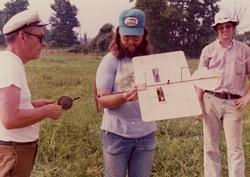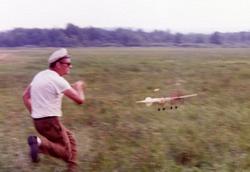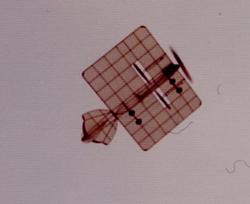"I became interested in the Mozhaiskii machine from
reading an article in the April-June 1974 issue of NATIONAL AERONAUTICS,
a quarterly publication of the National Aeronautical Association in the
USA.
I was hooked and, in wanting to make a model of it, I first decided to
try a glider made of card stock to see if I might learn
something of what might be expected from this odd design.
Of course, I rather thought the original machine may have had a cambered
airfoil, but decided to go with the flat plate, as shown in the
article's drawings, as it was more stable (up to about 15 degrees angle
of attack) than any cambered surface. To my delight the card stock model
proved quite stable even with the tail set at the same incidence angle
as the wing.
In laying out the rubber-powered flying model, I
decided to use power on all 3 props and to make them 4-bladed as well.
The motor for the nose prop was contained within the fuselage, while the
wing props were driven by motors suspended on motors sticks. These
sticks were mounted beneath the wing surface and extended from the props
forward to the leading edge. Rather short, but it helped to reduce the
ballast that had been added to establish the proper CG.
Glide tests of the model were okay, but not convincing. The turbulence
of the three 4-bladed props were taking a toll of the airflow over the
wing.
Winding the model took some time and deft handling. Launching the model
was not too easy. The right hand was place between the fore and aft
masts and their associated rigging. Thumb in the port propeller slot, 2
fingers in the starboard. This manoeuvre also restrained the outboard
props after the removal of the winding stops.
The left hand held the propeller. An underhand launch was then
effected at a slow trot. Extrication of the right hand without snagging
was not always a success, but it was never disastrous. I had nowhere
near the trepidation Mozhaiskii's pilot must have had!
The model never flew very high, nor very far, but it was very stable and
showed no vices. I cannot recall it ever stalling. Its flying
speed was quite low and it usually landed with power still being
delivered to the nose prop. The longest flight I recall was only
about 30 seconds.
I tried to fly the model on power to the central propeller alone. The result was a long extended glide. The same held true when only the
outboard propellers were powered. Power to all three was truly necessary
for good flight, so it was indeed a trimotor.
I still have the model. It's quite crispy and a bit warped, so I doubt
its airworthy any longer."


